Resource and Talent Planning Report: Tesco's Strategy and Analysis
VerifiedAdded on 2021/02/20
|22
|6743
|46
Report
AI Summary
This report provides a comprehensive analysis of Tesco's resource and talent planning strategies. It begins with an overview of Tesco, its operations, and the types of labor it employs, including skilled, semi-skilled, unskilled, and contract labor. The report then delves into current labor market trends, such as the skills gap, the impact of the industrial revolution, and the importance of data management. It also examines relevant employment legislation, including the Employment Rights Act, the Health and Safety Act, and the Equality Act. The analysis further includes a detailed assessment of Tesco's skills requirements, encompassing problem-solving, customer service, multitasking, and linguistic skills. Finally, the report explores the recruitment and selection process, including job analysis and various methods of recruitment, and integrates the HR lifecycle with overall HR strategies, concluding with recommendations for improvement and further development. This assignment is designed to help students understand the complexities of resource and talent planning in a large multinational retail company like Tesco.
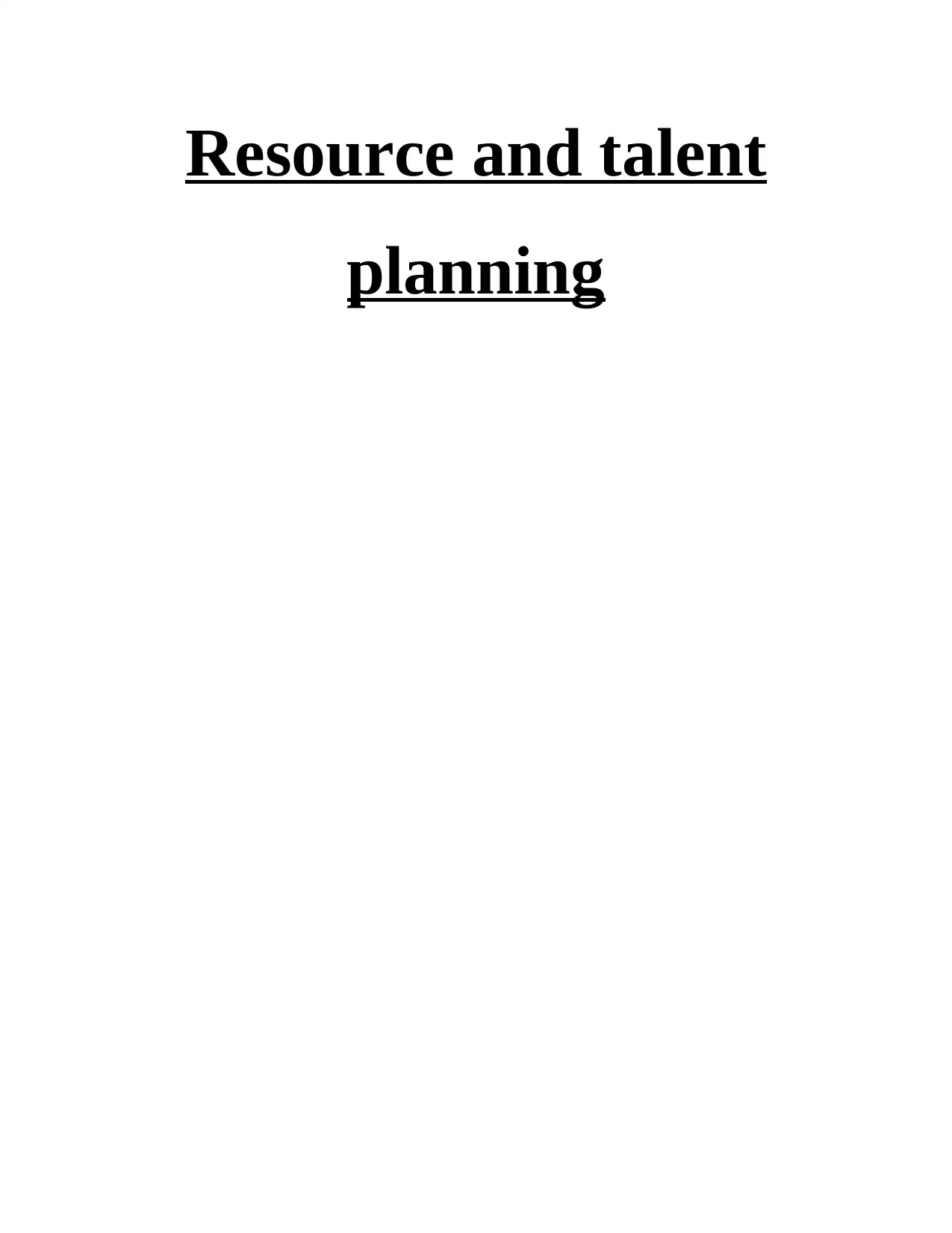
Resource and talent
planning
planning
Paraphrase This Document
Need a fresh take? Get an instant paraphrase of this document with our AI Paraphraser
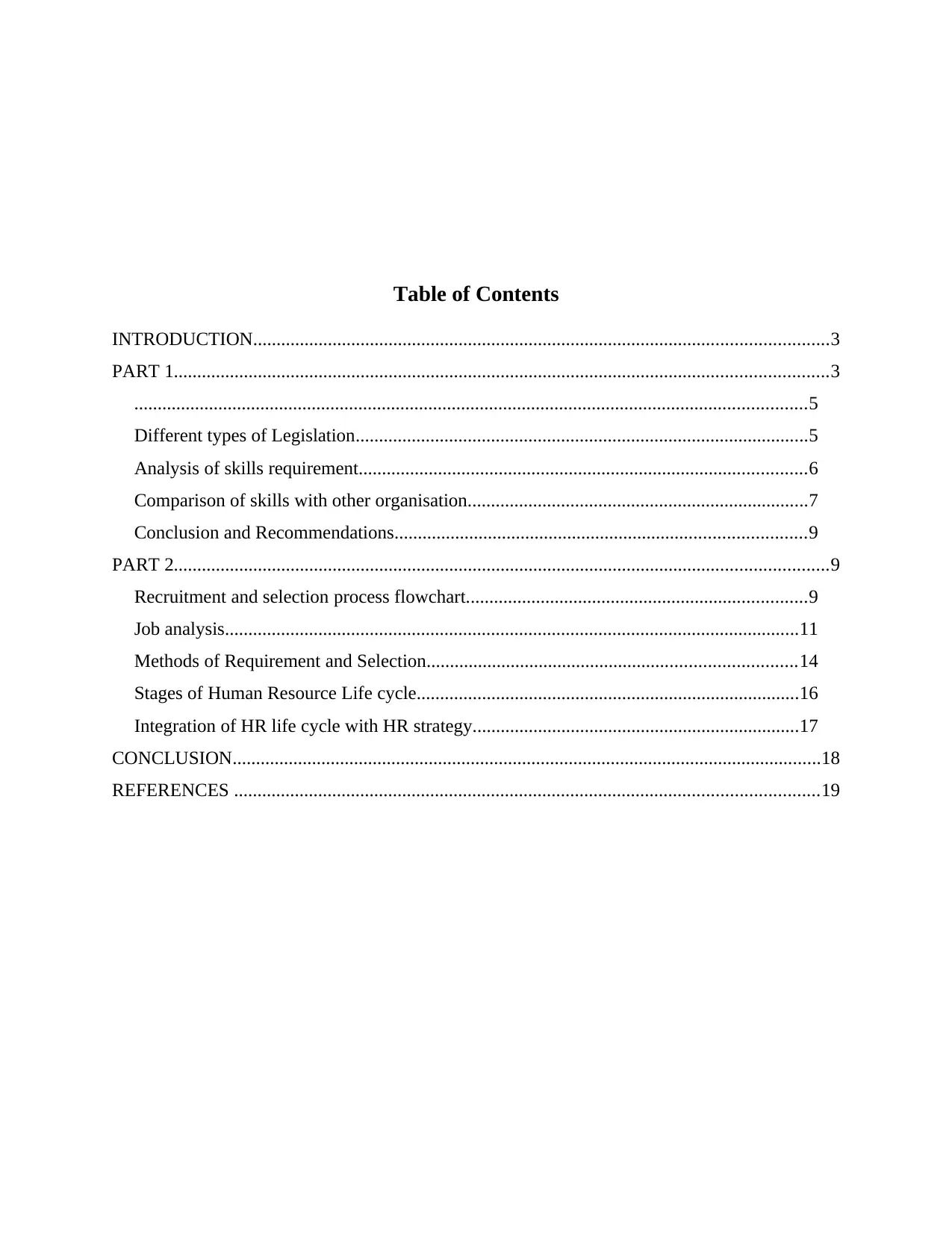
Table of Contents
INTRODUCTION...........................................................................................................................3
PART 1............................................................................................................................................3
................................................................................................................................................5
Different types of Legislation.................................................................................................5
Analysis of skills requirement................................................................................................6
Comparison of skills with other organisation.........................................................................7
Conclusion and Recommendations........................................................................................9
PART 2............................................................................................................................................9
Recruitment and selection process flowchart.........................................................................9
Job analysis...........................................................................................................................11
Methods of Requirement and Selection...............................................................................14
Stages of Human Resource Life cycle..................................................................................16
Integration of HR life cycle with HR strategy......................................................................17
CONCLUSION..............................................................................................................................18
REFERENCES .............................................................................................................................19
INTRODUCTION...........................................................................................................................3
PART 1............................................................................................................................................3
................................................................................................................................................5
Different types of Legislation.................................................................................................5
Analysis of skills requirement................................................................................................6
Comparison of skills with other organisation.........................................................................7
Conclusion and Recommendations........................................................................................9
PART 2............................................................................................................................................9
Recruitment and selection process flowchart.........................................................................9
Job analysis...........................................................................................................................11
Methods of Requirement and Selection...............................................................................14
Stages of Human Resource Life cycle..................................................................................16
Integration of HR life cycle with HR strategy......................................................................17
CONCLUSION..............................................................................................................................18
REFERENCES .............................................................................................................................19
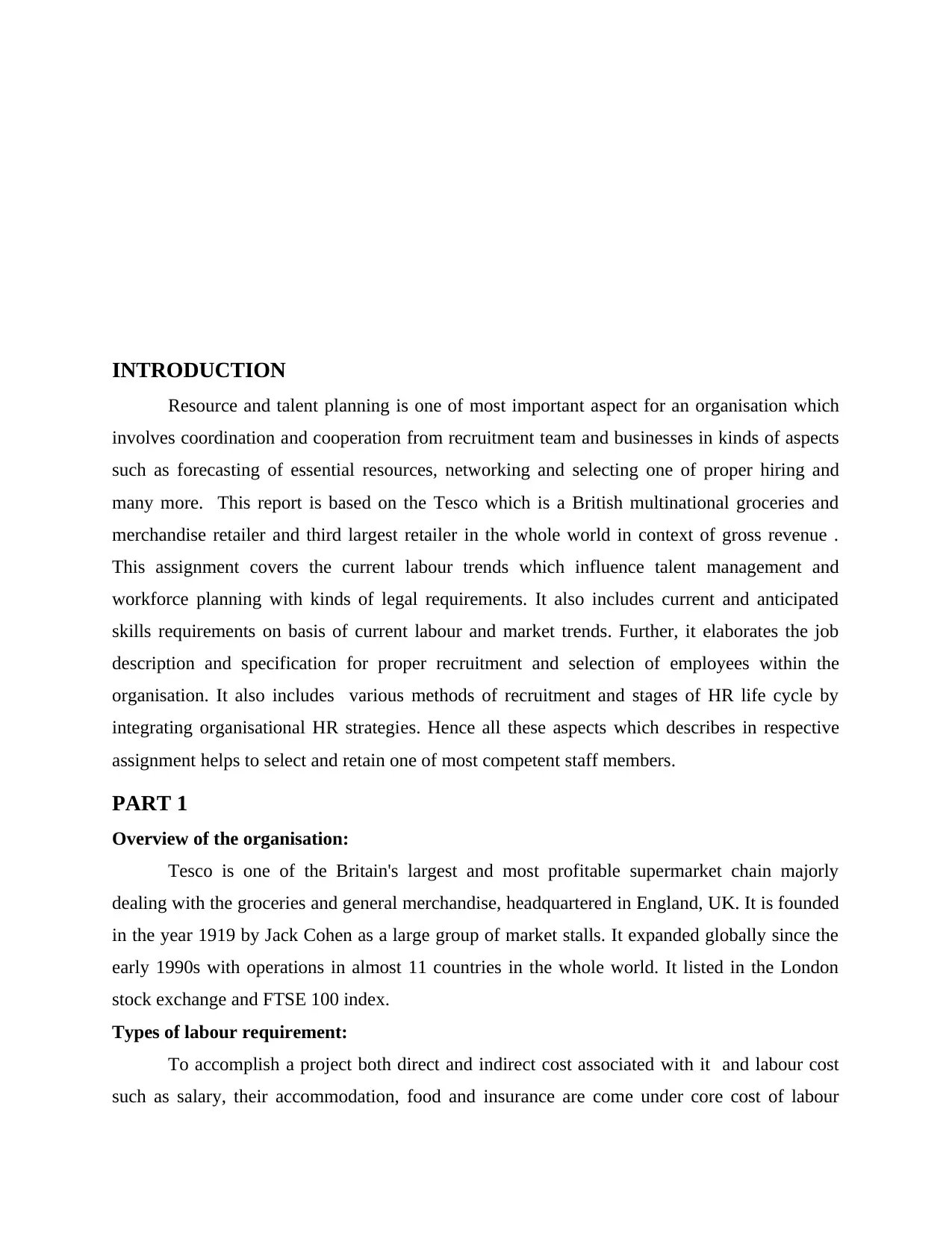
INTRODUCTION
Resource and talent planning is one of most important aspect for an organisation which
involves coordination and cooperation from recruitment team and businesses in kinds of aspects
such as forecasting of essential resources, networking and selecting one of proper hiring and
many more. This report is based on the Tesco which is a British multinational groceries and
merchandise retailer and third largest retailer in the whole world in context of gross revenue .
This assignment covers the current labour trends which influence talent management and
workforce planning with kinds of legal requirements. It also includes current and anticipated
skills requirements on basis of current labour and market trends. Further, it elaborates the job
description and specification for proper recruitment and selection of employees within the
organisation. It also includes various methods of recruitment and stages of HR life cycle by
integrating organisational HR strategies. Hence all these aspects which describes in respective
assignment helps to select and retain one of most competent staff members.
PART 1
Overview of the organisation:
Tesco is one of the Britain's largest and most profitable supermarket chain majorly
dealing with the groceries and general merchandise, headquartered in England, UK. It is founded
in the year 1919 by Jack Cohen as a large group of market stalls. It expanded globally since the
early 1990s with operations in almost 11 countries in the whole world. It listed in the London
stock exchange and FTSE 100 index.
Types of labour requirement:
To accomplish a project both direct and indirect cost associated with it and labour cost
such as salary, their accommodation, food and insurance are come under core cost of labour
Resource and talent planning is one of most important aspect for an organisation which
involves coordination and cooperation from recruitment team and businesses in kinds of aspects
such as forecasting of essential resources, networking and selecting one of proper hiring and
many more. This report is based on the Tesco which is a British multinational groceries and
merchandise retailer and third largest retailer in the whole world in context of gross revenue .
This assignment covers the current labour trends which influence talent management and
workforce planning with kinds of legal requirements. It also includes current and anticipated
skills requirements on basis of current labour and market trends. Further, it elaborates the job
description and specification for proper recruitment and selection of employees within the
organisation. It also includes various methods of recruitment and stages of HR life cycle by
integrating organisational HR strategies. Hence all these aspects which describes in respective
assignment helps to select and retain one of most competent staff members.
PART 1
Overview of the organisation:
Tesco is one of the Britain's largest and most profitable supermarket chain majorly
dealing with the groceries and general merchandise, headquartered in England, UK. It is founded
in the year 1919 by Jack Cohen as a large group of market stalls. It expanded globally since the
early 1990s with operations in almost 11 countries in the whole world. It listed in the London
stock exchange and FTSE 100 index.
Types of labour requirement:
To accomplish a project both direct and indirect cost associated with it and labour cost
such as salary, their accommodation, food and insurance are come under core cost of labour
⊘ This is a preview!⊘
Do you want full access?
Subscribe today to unlock all pages.

Trusted by 1+ million students worldwide
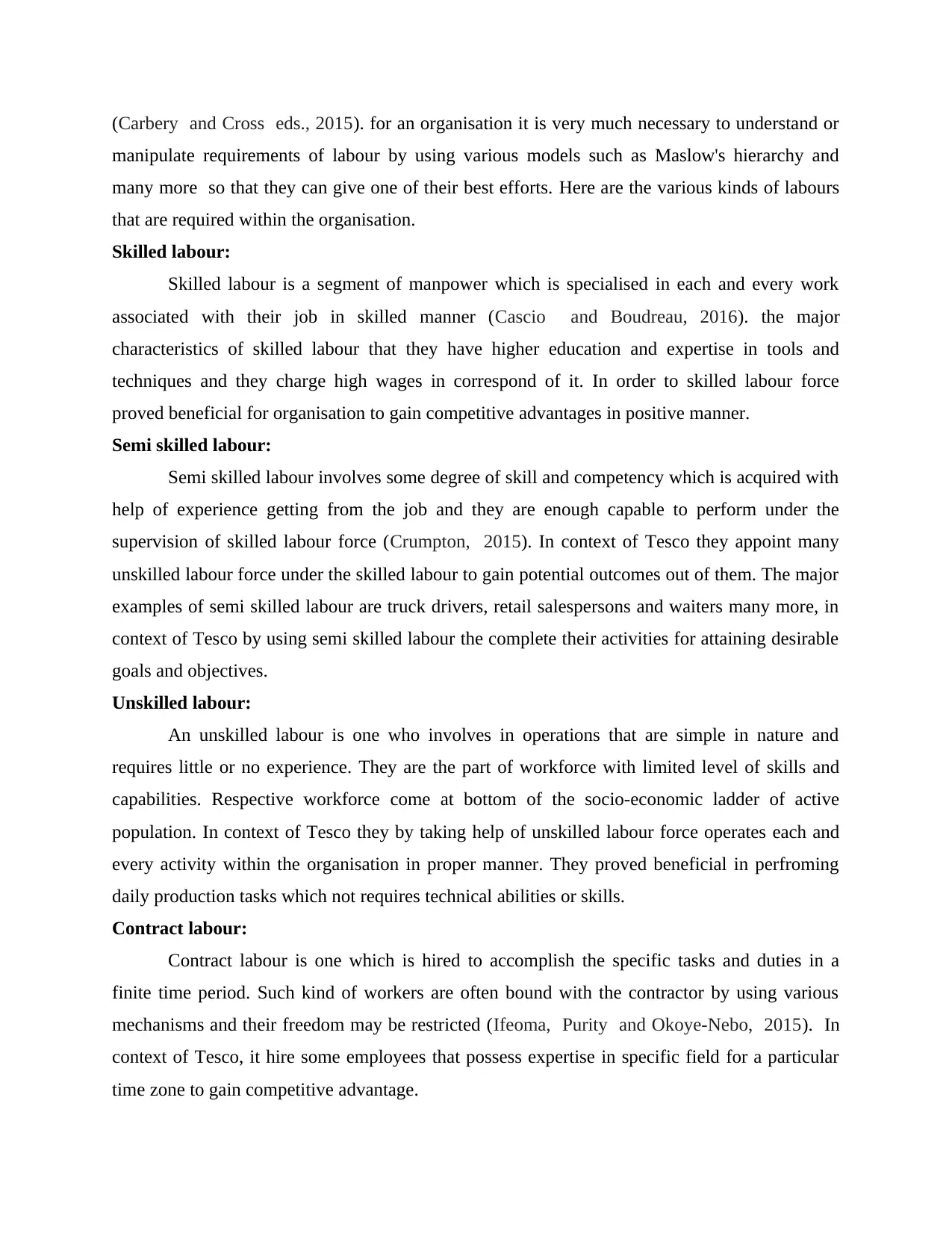
(Carbery and Cross eds., 2015). for an organisation it is very much necessary to understand or
manipulate requirements of labour by using various models such as Maslow's hierarchy and
many more so that they can give one of their best efforts. Here are the various kinds of labours
that are required within the organisation.
Skilled labour:
Skilled labour is a segment of manpower which is specialised in each and every work
associated with their job in skilled manner (Cascio and Boudreau, 2016). the major
characteristics of skilled labour that they have higher education and expertise in tools and
techniques and they charge high wages in correspond of it. In order to skilled labour force
proved beneficial for organisation to gain competitive advantages in positive manner.
Semi skilled labour:
Semi skilled labour involves some degree of skill and competency which is acquired with
help of experience getting from the job and they are enough capable to perform under the
supervision of skilled labour force (Crumpton, 2015). In context of Tesco they appoint many
unskilled labour force under the skilled labour to gain potential outcomes out of them. The major
examples of semi skilled labour are truck drivers, retail salespersons and waiters many more, in
context of Tesco by using semi skilled labour the complete their activities for attaining desirable
goals and objectives.
Unskilled labour:
An unskilled labour is one who involves in operations that are simple in nature and
requires little or no experience. They are the part of workforce with limited level of skills and
capabilities. Respective workforce come at bottom of the socio-economic ladder of active
population. In context of Tesco they by taking help of unskilled labour force operates each and
every activity within the organisation in proper manner. They proved beneficial in perfroming
daily production tasks which not requires technical abilities or skills.
Contract labour:
Contract labour is one which is hired to accomplish the specific tasks and duties in a
finite time period. Such kind of workers are often bound with the contractor by using various
mechanisms and their freedom may be restricted (Ifeoma, Purity and Okoye-Nebo, 2015). In
context of Tesco, it hire some employees that possess expertise in specific field for a particular
time zone to gain competitive advantage.
manipulate requirements of labour by using various models such as Maslow's hierarchy and
many more so that they can give one of their best efforts. Here are the various kinds of labours
that are required within the organisation.
Skilled labour:
Skilled labour is a segment of manpower which is specialised in each and every work
associated with their job in skilled manner (Cascio and Boudreau, 2016). the major
characteristics of skilled labour that they have higher education and expertise in tools and
techniques and they charge high wages in correspond of it. In order to skilled labour force
proved beneficial for organisation to gain competitive advantages in positive manner.
Semi skilled labour:
Semi skilled labour involves some degree of skill and competency which is acquired with
help of experience getting from the job and they are enough capable to perform under the
supervision of skilled labour force (Crumpton, 2015). In context of Tesco they appoint many
unskilled labour force under the skilled labour to gain potential outcomes out of them. The major
examples of semi skilled labour are truck drivers, retail salespersons and waiters many more, in
context of Tesco by using semi skilled labour the complete their activities for attaining desirable
goals and objectives.
Unskilled labour:
An unskilled labour is one who involves in operations that are simple in nature and
requires little or no experience. They are the part of workforce with limited level of skills and
capabilities. Respective workforce come at bottom of the socio-economic ladder of active
population. In context of Tesco they by taking help of unskilled labour force operates each and
every activity within the organisation in proper manner. They proved beneficial in perfroming
daily production tasks which not requires technical abilities or skills.
Contract labour:
Contract labour is one which is hired to accomplish the specific tasks and duties in a
finite time period. Such kind of workers are often bound with the contractor by using various
mechanisms and their freedom may be restricted (Ifeoma, Purity and Okoye-Nebo, 2015). In
context of Tesco, it hire some employees that possess expertise in specific field for a particular
time zone to gain competitive advantage.
Paraphrase This Document
Need a fresh take? Get an instant paraphrase of this document with our AI Paraphraser
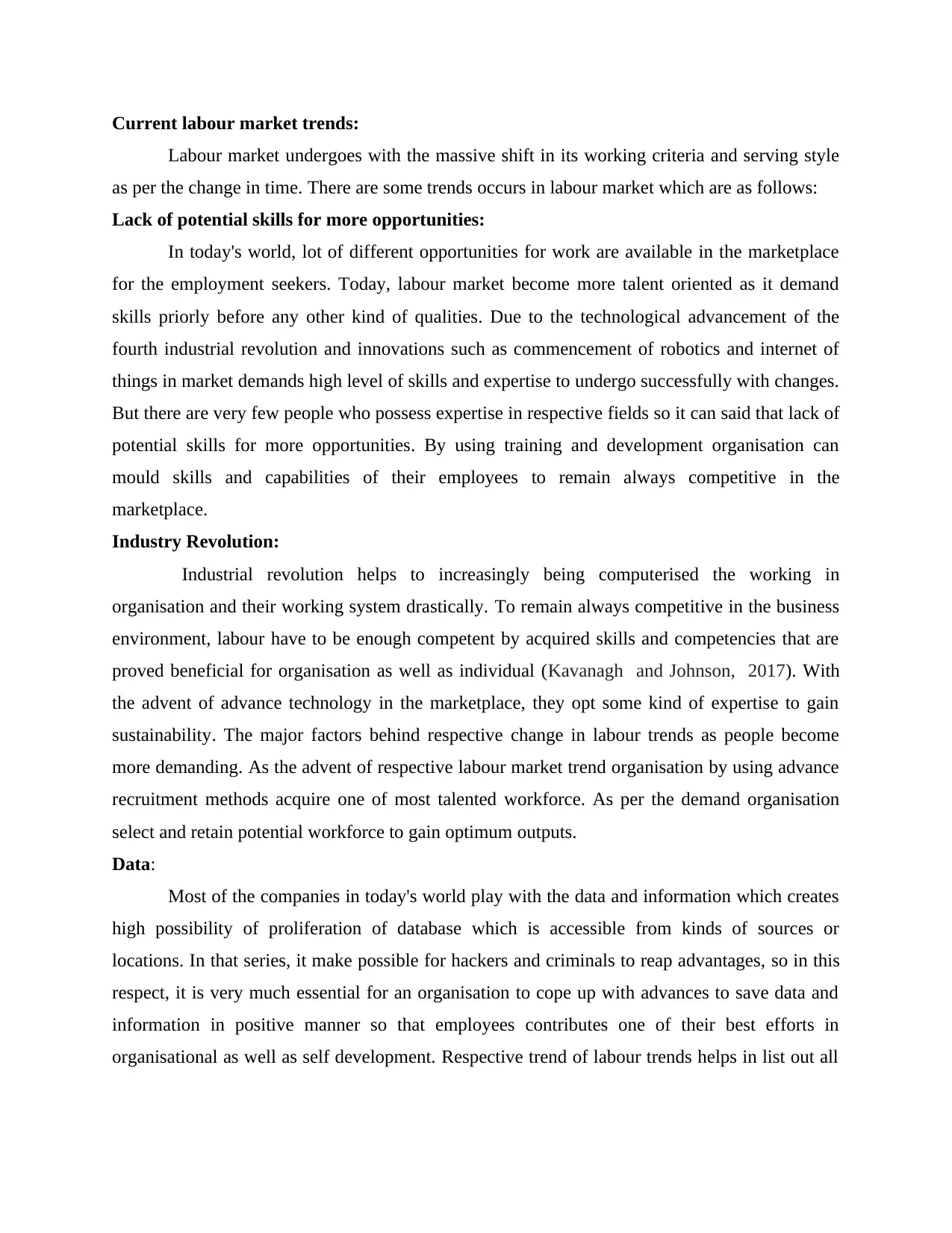
Current labour market trends:
Labour market undergoes with the massive shift in its working criteria and serving style
as per the change in time. There are some trends occurs in labour market which are as follows:
Lack of potential skills for more opportunities:
In today's world, lot of different opportunities for work are available in the marketplace
for the employment seekers. Today, labour market become more talent oriented as it demand
skills priorly before any other kind of qualities. Due to the technological advancement of the
fourth industrial revolution and innovations such as commencement of robotics and internet of
things in market demands high level of skills and expertise to undergo successfully with changes.
But there are very few people who possess expertise in respective fields so it can said that lack of
potential skills for more opportunities. By using training and development organisation can
mould skills and capabilities of their employees to remain always competitive in the
marketplace.
Industry Revolution:
Industrial revolution helps to increasingly being computerised the working in
organisation and their working system drastically. To remain always competitive in the business
environment, labour have to be enough competent by acquired skills and competencies that are
proved beneficial for organisation as well as individual (Kavanagh and Johnson, 2017). With
the advent of advance technology in the marketplace, they opt some kind of expertise to gain
sustainability. The major factors behind respective change in labour trends as people become
more demanding. As the advent of respective labour market trend organisation by using advance
recruitment methods acquire one of most talented workforce. As per the demand organisation
select and retain potential workforce to gain optimum outputs.
Data:
Most of the companies in today's world play with the data and information which creates
high possibility of proliferation of database which is accessible from kinds of sources or
locations. In that series, it make possible for hackers and criminals to reap advantages, so in this
respect, it is very much essential for an organisation to cope up with advances to save data and
information in positive manner so that employees contributes one of their best efforts in
organisational as well as self development. Respective trend of labour trends helps in list out all
Labour market undergoes with the massive shift in its working criteria and serving style
as per the change in time. There are some trends occurs in labour market which are as follows:
Lack of potential skills for more opportunities:
In today's world, lot of different opportunities for work are available in the marketplace
for the employment seekers. Today, labour market become more talent oriented as it demand
skills priorly before any other kind of qualities. Due to the technological advancement of the
fourth industrial revolution and innovations such as commencement of robotics and internet of
things in market demands high level of skills and expertise to undergo successfully with changes.
But there are very few people who possess expertise in respective fields so it can said that lack of
potential skills for more opportunities. By using training and development organisation can
mould skills and capabilities of their employees to remain always competitive in the
marketplace.
Industry Revolution:
Industrial revolution helps to increasingly being computerised the working in
organisation and their working system drastically. To remain always competitive in the business
environment, labour have to be enough competent by acquired skills and competencies that are
proved beneficial for organisation as well as individual (Kavanagh and Johnson, 2017). With
the advent of advance technology in the marketplace, they opt some kind of expertise to gain
sustainability. The major factors behind respective change in labour trends as people become
more demanding. As the advent of respective labour market trend organisation by using advance
recruitment methods acquire one of most talented workforce. As per the demand organisation
select and retain potential workforce to gain optimum outputs.
Data:
Most of the companies in today's world play with the data and information which creates
high possibility of proliferation of database which is accessible from kinds of sources or
locations. In that series, it make possible for hackers and criminals to reap advantages, so in this
respect, it is very much essential for an organisation to cope up with advances to save data and
information in positive manner so that employees contributes one of their best efforts in
organisational as well as self development. Respective trend of labour trends helps in list out all
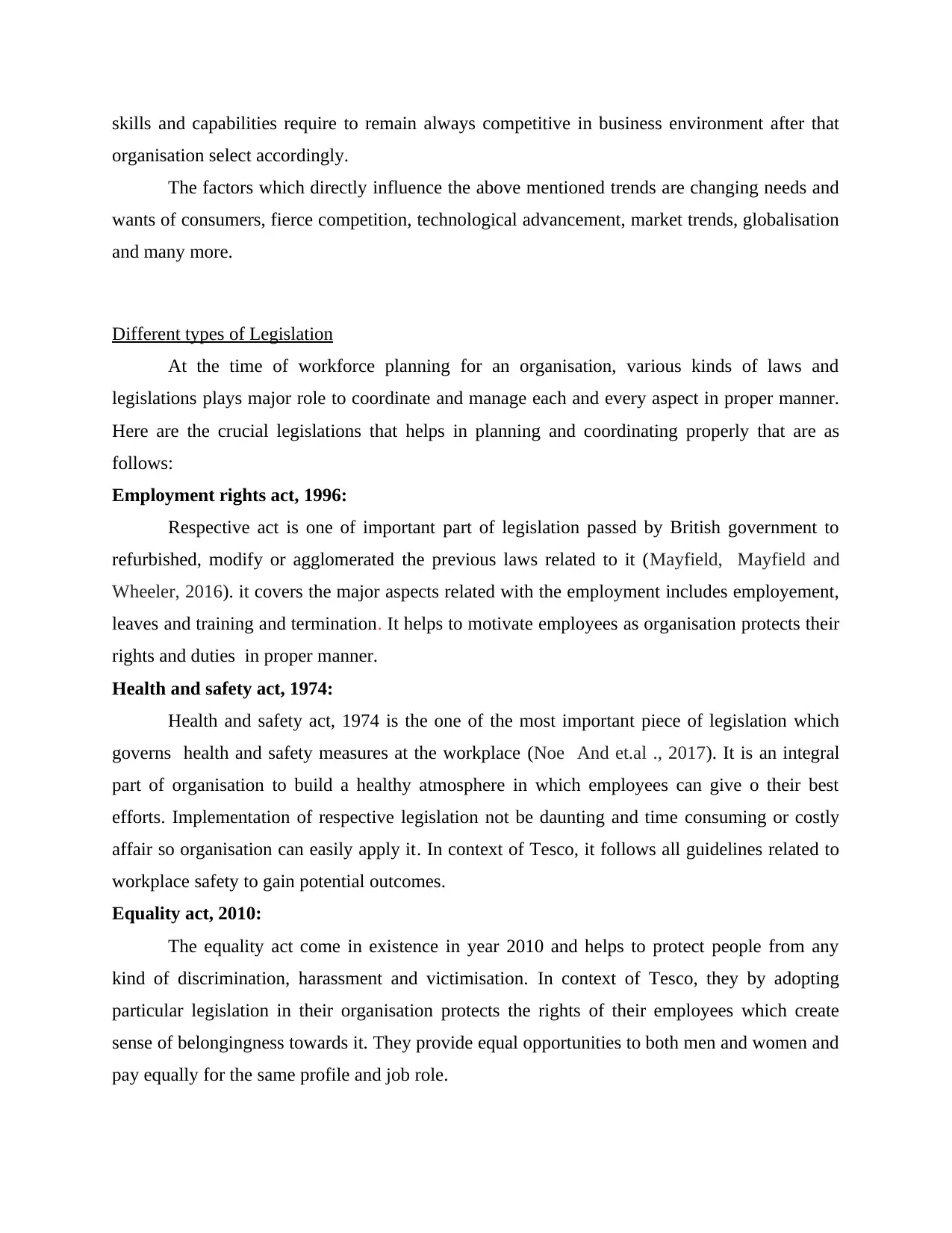
skills and capabilities require to remain always competitive in business environment after that
organisation select accordingly.
The factors which directly influence the above mentioned trends are changing needs and
wants of consumers, fierce competition, technological advancement, market trends, globalisation
and many more.
Different types of Legislation
At the time of workforce planning for an organisation, various kinds of laws and
legislations plays major role to coordinate and manage each and every aspect in proper manner.
Here are the crucial legislations that helps in planning and coordinating properly that are as
follows:
Employment rights act, 1996:
Respective act is one of important part of legislation passed by British government to
refurbished, modify or agglomerated the previous laws related to it (Mayfield, Mayfield and
Wheeler, 2016). it covers the major aspects related with the employment includes employement,
leaves and training and termination. It helps to motivate employees as organisation protects their
rights and duties in proper manner.
Health and safety act, 1974:
Health and safety act, 1974 is the one of the most important piece of legislation which
governs health and safety measures at the workplace (Noe And et.al ., 2017). It is an integral
part of organisation to build a healthy atmosphere in which employees can give o their best
efforts. Implementation of respective legislation not be daunting and time consuming or costly
affair so organisation can easily apply it. In context of Tesco, it follows all guidelines related to
workplace safety to gain potential outcomes.
Equality act, 2010:
The equality act come in existence in year 2010 and helps to protect people from any
kind of discrimination, harassment and victimisation. In context of Tesco, they by adopting
particular legislation in their organisation protects the rights of their employees which create
sense of belongingness towards it. They provide equal opportunities to both men and women and
pay equally for the same profile and job role.
organisation select accordingly.
The factors which directly influence the above mentioned trends are changing needs and
wants of consumers, fierce competition, technological advancement, market trends, globalisation
and many more.
Different types of Legislation
At the time of workforce planning for an organisation, various kinds of laws and
legislations plays major role to coordinate and manage each and every aspect in proper manner.
Here are the crucial legislations that helps in planning and coordinating properly that are as
follows:
Employment rights act, 1996:
Respective act is one of important part of legislation passed by British government to
refurbished, modify or agglomerated the previous laws related to it (Mayfield, Mayfield and
Wheeler, 2016). it covers the major aspects related with the employment includes employement,
leaves and training and termination. It helps to motivate employees as organisation protects their
rights and duties in proper manner.
Health and safety act, 1974:
Health and safety act, 1974 is the one of the most important piece of legislation which
governs health and safety measures at the workplace (Noe And et.al ., 2017). It is an integral
part of organisation to build a healthy atmosphere in which employees can give o their best
efforts. Implementation of respective legislation not be daunting and time consuming or costly
affair so organisation can easily apply it. In context of Tesco, it follows all guidelines related to
workplace safety to gain potential outcomes.
Equality act, 2010:
The equality act come in existence in year 2010 and helps to protect people from any
kind of discrimination, harassment and victimisation. In context of Tesco, they by adopting
particular legislation in their organisation protects the rights of their employees which create
sense of belongingness towards it. They provide equal opportunities to both men and women and
pay equally for the same profile and job role.
⊘ This is a preview!⊘
Do you want full access?
Subscribe today to unlock all pages.

Trusted by 1+ million students worldwide
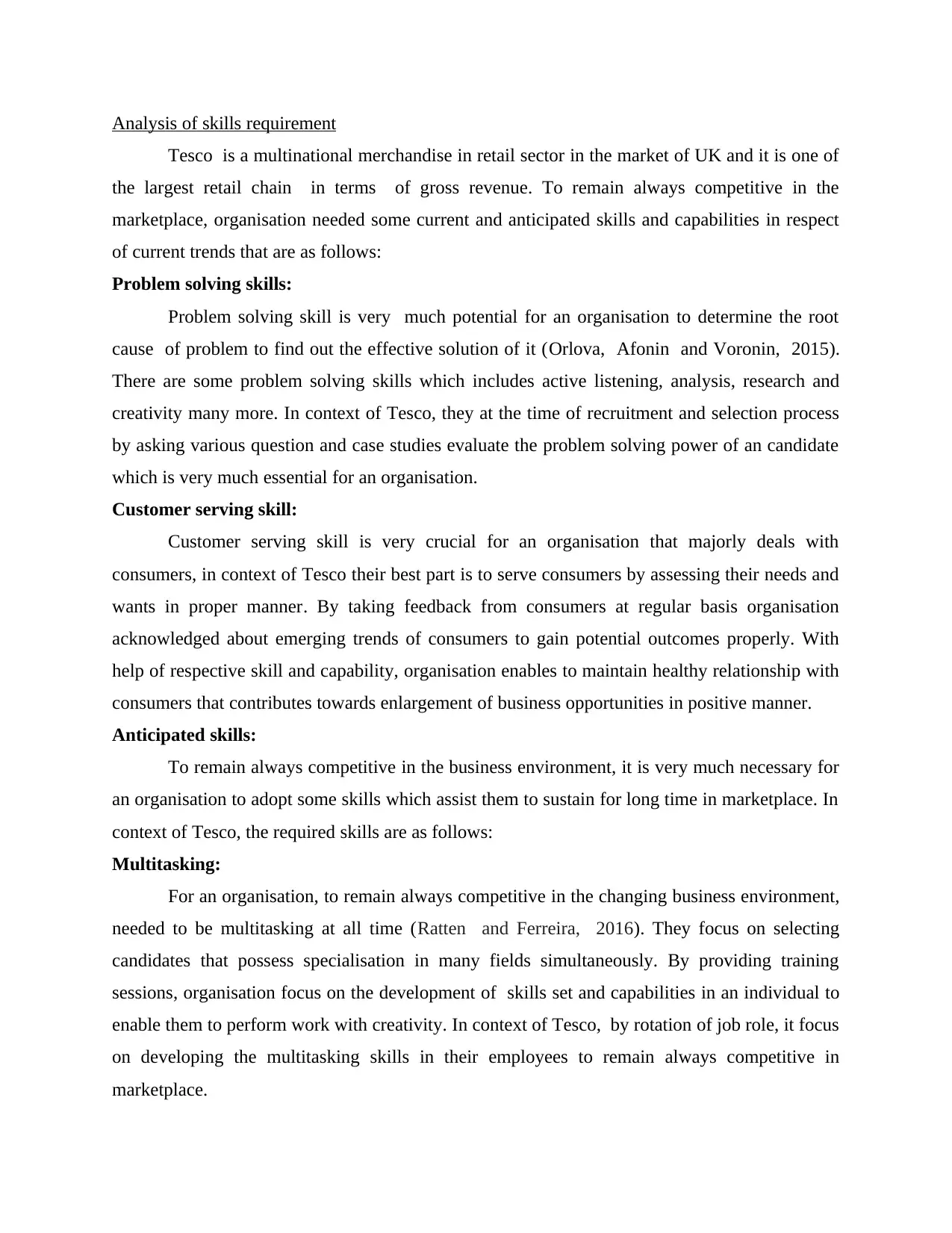
Analysis of skills requirement
Tesco is a multinational merchandise in retail sector in the market of UK and it is one of
the largest retail chain in terms of gross revenue. To remain always competitive in the
marketplace, organisation needed some current and anticipated skills and capabilities in respect
of current trends that are as follows:
Problem solving skills:
Problem solving skill is very much potential for an organisation to determine the root
cause of problem to find out the effective solution of it (Orlova, Afonin and Voronin, 2015).
There are some problem solving skills which includes active listening, analysis, research and
creativity many more. In context of Tesco, they at the time of recruitment and selection process
by asking various question and case studies evaluate the problem solving power of an candidate
which is very much essential for an organisation.
Customer serving skill:
Customer serving skill is very crucial for an organisation that majorly deals with
consumers, in context of Tesco their best part is to serve consumers by assessing their needs and
wants in proper manner. By taking feedback from consumers at regular basis organisation
acknowledged about emerging trends of consumers to gain potential outcomes properly. With
help of respective skill and capability, organisation enables to maintain healthy relationship with
consumers that contributes towards enlargement of business opportunities in positive manner.
Anticipated skills:
To remain always competitive in the business environment, it is very much necessary for
an organisation to adopt some skills which assist them to sustain for long time in marketplace. In
context of Tesco, the required skills are as follows:
Multitasking:
For an organisation, to remain always competitive in the changing business environment,
needed to be multitasking at all time (Ratten and Ferreira, 2016). They focus on selecting
candidates that possess specialisation in many fields simultaneously. By providing training
sessions, organisation focus on the development of skills set and capabilities in an individual to
enable them to perform work with creativity. In context of Tesco, by rotation of job role, it focus
on developing the multitasking skills in their employees to remain always competitive in
marketplace.
Tesco is a multinational merchandise in retail sector in the market of UK and it is one of
the largest retail chain in terms of gross revenue. To remain always competitive in the
marketplace, organisation needed some current and anticipated skills and capabilities in respect
of current trends that are as follows:
Problem solving skills:
Problem solving skill is very much potential for an organisation to determine the root
cause of problem to find out the effective solution of it (Orlova, Afonin and Voronin, 2015).
There are some problem solving skills which includes active listening, analysis, research and
creativity many more. In context of Tesco, they at the time of recruitment and selection process
by asking various question and case studies evaluate the problem solving power of an candidate
which is very much essential for an organisation.
Customer serving skill:
Customer serving skill is very crucial for an organisation that majorly deals with
consumers, in context of Tesco their best part is to serve consumers by assessing their needs and
wants in proper manner. By taking feedback from consumers at regular basis organisation
acknowledged about emerging trends of consumers to gain potential outcomes properly. With
help of respective skill and capability, organisation enables to maintain healthy relationship with
consumers that contributes towards enlargement of business opportunities in positive manner.
Anticipated skills:
To remain always competitive in the business environment, it is very much necessary for
an organisation to adopt some skills which assist them to sustain for long time in marketplace. In
context of Tesco, the required skills are as follows:
Multitasking:
For an organisation, to remain always competitive in the changing business environment,
needed to be multitasking at all time (Ratten and Ferreira, 2016). They focus on selecting
candidates that possess specialisation in many fields simultaneously. By providing training
sessions, organisation focus on the development of skills set and capabilities in an individual to
enable them to perform work with creativity. In context of Tesco, by rotation of job role, it focus
on developing the multitasking skills in their employees to remain always competitive in
marketplace.
Paraphrase This Document
Need a fresh take? Get an instant paraphrase of this document with our AI Paraphraser
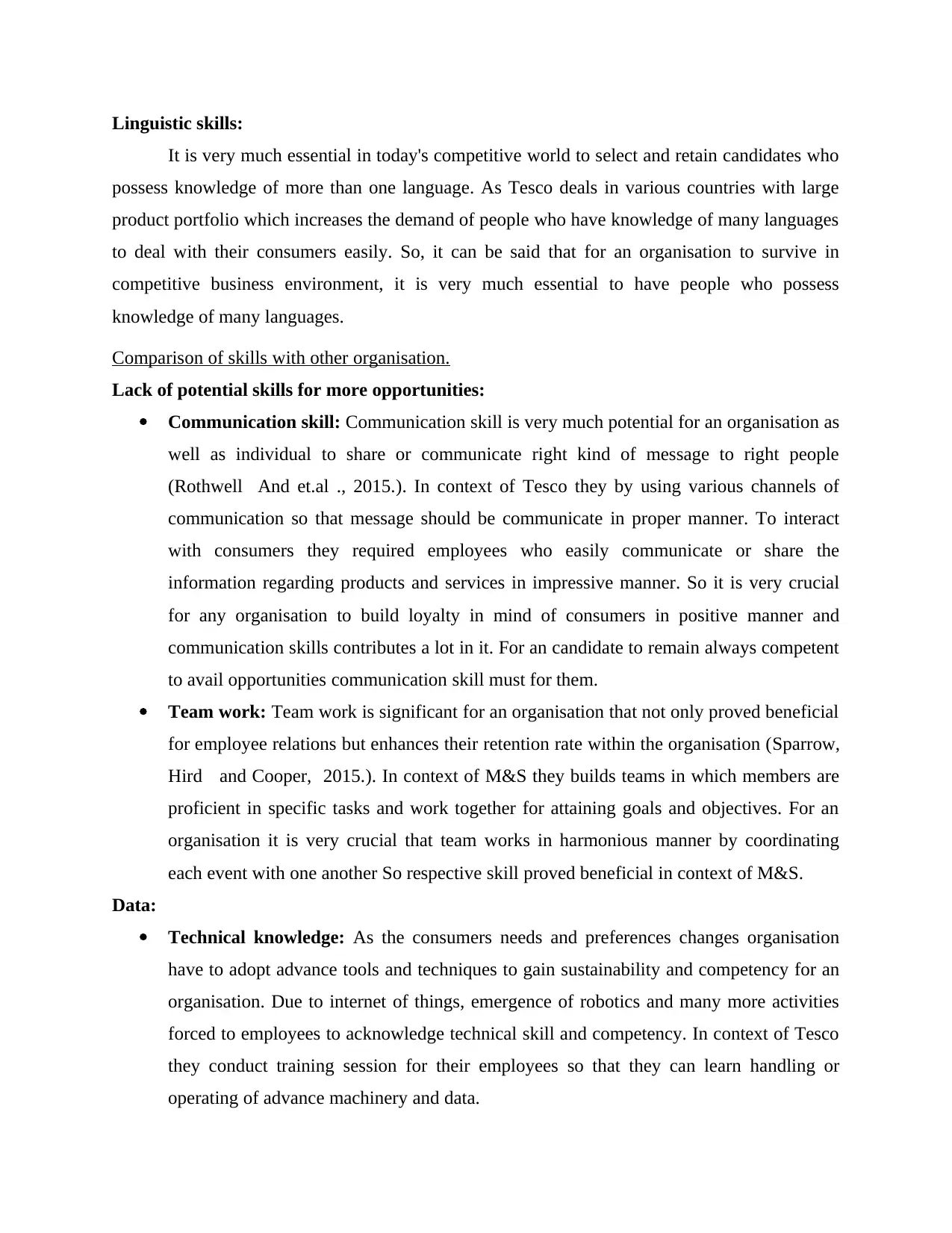
Linguistic skills:
It is very much essential in today's competitive world to select and retain candidates who
possess knowledge of more than one language. As Tesco deals in various countries with large
product portfolio which increases the demand of people who have knowledge of many languages
to deal with their consumers easily. So, it can be said that for an organisation to survive in
competitive business environment, it is very much essential to have people who possess
knowledge of many languages.
Comparison of skills with other organisation.
Lack of potential skills for more opportunities:
Communication skill: Communication skill is very much potential for an organisation as
well as individual to share or communicate right kind of message to right people
(Rothwell And et.al ., 2015.). In context of Tesco they by using various channels of
communication so that message should be communicate in proper manner. To interact
with consumers they required employees who easily communicate or share the
information regarding products and services in impressive manner. So it is very crucial
for any organisation to build loyalty in mind of consumers in positive manner and
communication skills contributes a lot in it. For an candidate to remain always competent
to avail opportunities communication skill must for them.
Team work: Team work is significant for an organisation that not only proved beneficial
for employee relations but enhances their retention rate within the organisation (Sparrow,
Hird and Cooper, 2015.). In context of M&S they builds teams in which members are
proficient in specific tasks and work together for attaining goals and objectives. For an
organisation it is very crucial that team works in harmonious manner by coordinating
each event with one another So respective skill proved beneficial in context of M&S.
Data:
Technical knowledge: As the consumers needs and preferences changes organisation
have to adopt advance tools and techniques to gain sustainability and competency for an
organisation. Due to internet of things, emergence of robotics and many more activities
forced to employees to acknowledge technical skill and competency. In context of Tesco
they conduct training session for their employees so that they can learn handling or
operating of advance machinery and data.
It is very much essential in today's competitive world to select and retain candidates who
possess knowledge of more than one language. As Tesco deals in various countries with large
product portfolio which increases the demand of people who have knowledge of many languages
to deal with their consumers easily. So, it can be said that for an organisation to survive in
competitive business environment, it is very much essential to have people who possess
knowledge of many languages.
Comparison of skills with other organisation.
Lack of potential skills for more opportunities:
Communication skill: Communication skill is very much potential for an organisation as
well as individual to share or communicate right kind of message to right people
(Rothwell And et.al ., 2015.). In context of Tesco they by using various channels of
communication so that message should be communicate in proper manner. To interact
with consumers they required employees who easily communicate or share the
information regarding products and services in impressive manner. So it is very crucial
for any organisation to build loyalty in mind of consumers in positive manner and
communication skills contributes a lot in it. For an candidate to remain always competent
to avail opportunities communication skill must for them.
Team work: Team work is significant for an organisation that not only proved beneficial
for employee relations but enhances their retention rate within the organisation (Sparrow,
Hird and Cooper, 2015.). In context of M&S they builds teams in which members are
proficient in specific tasks and work together for attaining goals and objectives. For an
organisation it is very crucial that team works in harmonious manner by coordinating
each event with one another So respective skill proved beneficial in context of M&S.
Data:
Technical knowledge: As the consumers needs and preferences changes organisation
have to adopt advance tools and techniques to gain sustainability and competency for an
organisation. Due to internet of things, emergence of robotics and many more activities
forced to employees to acknowledge technical skill and competency. In context of Tesco
they conduct training session for their employees so that they can learn handling or
operating of advance machinery and data.
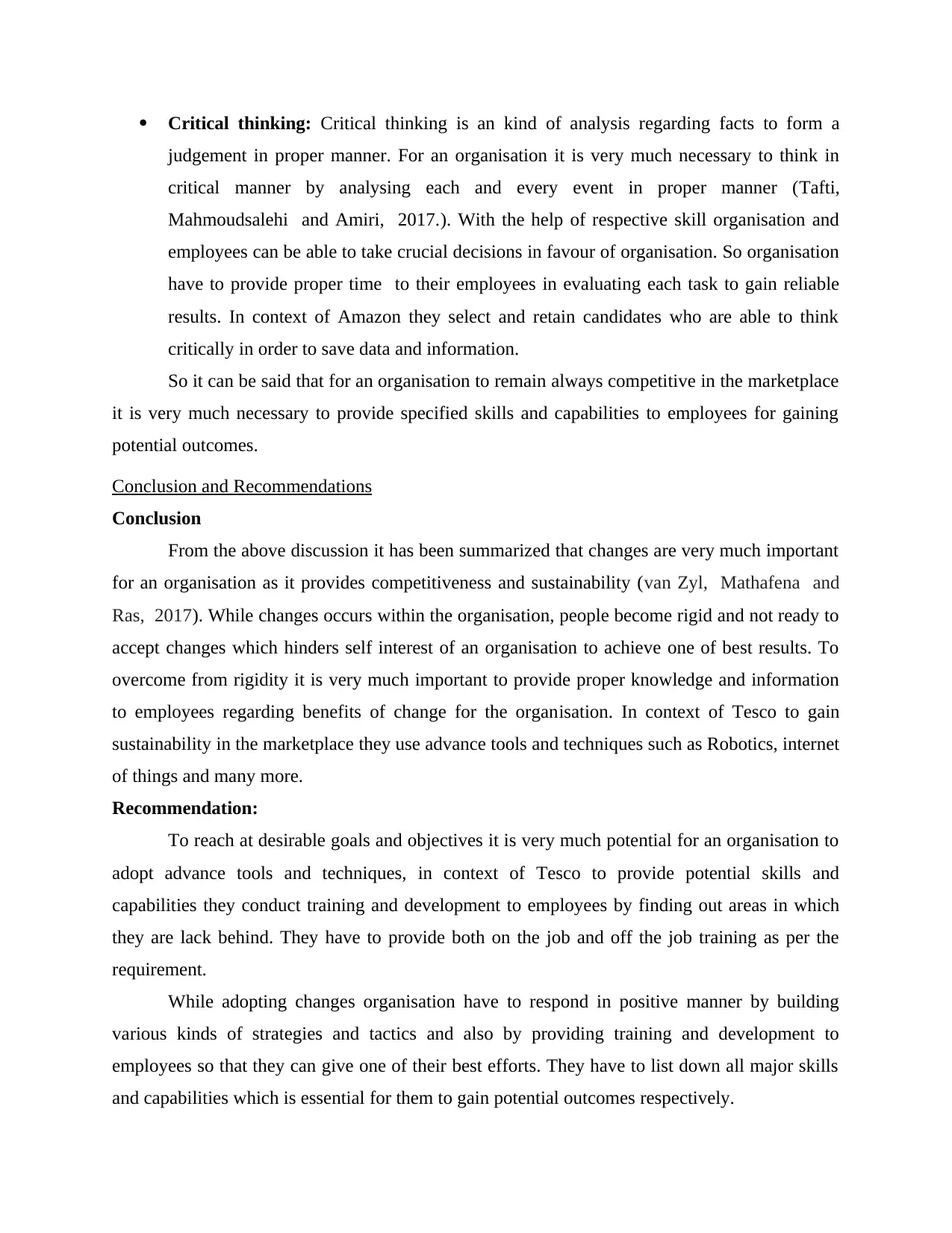
Critical thinking: Critical thinking is an kind of analysis regarding facts to form a
judgement in proper manner. For an organisation it is very much necessary to think in
critical manner by analysing each and every event in proper manner (Tafti,
Mahmoudsalehi and Amiri, 2017.). With the help of respective skill organisation and
employees can be able to take crucial decisions in favour of organisation. So organisation
have to provide proper time to their employees in evaluating each task to gain reliable
results. In context of Amazon they select and retain candidates who are able to think
critically in order to save data and information.
So it can be said that for an organisation to remain always competitive in the marketplace
it is very much necessary to provide specified skills and capabilities to employees for gaining
potential outcomes.
Conclusion and Recommendations
Conclusion
From the above discussion it has been summarized that changes are very much important
for an organisation as it provides competitiveness and sustainability (van Zyl, Mathafena and
Ras, 2017). While changes occurs within the organisation, people become rigid and not ready to
accept changes which hinders self interest of an organisation to achieve one of best results. To
overcome from rigidity it is very much important to provide proper knowledge and information
to employees regarding benefits of change for the organisation. In context of Tesco to gain
sustainability in the marketplace they use advance tools and techniques such as Robotics, internet
of things and many more.
Recommendation:
To reach at desirable goals and objectives it is very much potential for an organisation to
adopt advance tools and techniques, in context of Tesco to provide potential skills and
capabilities they conduct training and development to employees by finding out areas in which
they are lack behind. They have to provide both on the job and off the job training as per the
requirement.
While adopting changes organisation have to respond in positive manner by building
various kinds of strategies and tactics and also by providing training and development to
employees so that they can give one of their best efforts. They have to list down all major skills
and capabilities which is essential for them to gain potential outcomes respectively.
judgement in proper manner. For an organisation it is very much necessary to think in
critical manner by analysing each and every event in proper manner (Tafti,
Mahmoudsalehi and Amiri, 2017.). With the help of respective skill organisation and
employees can be able to take crucial decisions in favour of organisation. So organisation
have to provide proper time to their employees in evaluating each task to gain reliable
results. In context of Amazon they select and retain candidates who are able to think
critically in order to save data and information.
So it can be said that for an organisation to remain always competitive in the marketplace
it is very much necessary to provide specified skills and capabilities to employees for gaining
potential outcomes.
Conclusion and Recommendations
Conclusion
From the above discussion it has been summarized that changes are very much important
for an organisation as it provides competitiveness and sustainability (van Zyl, Mathafena and
Ras, 2017). While changes occurs within the organisation, people become rigid and not ready to
accept changes which hinders self interest of an organisation to achieve one of best results. To
overcome from rigidity it is very much important to provide proper knowledge and information
to employees regarding benefits of change for the organisation. In context of Tesco to gain
sustainability in the marketplace they use advance tools and techniques such as Robotics, internet
of things and many more.
Recommendation:
To reach at desirable goals and objectives it is very much potential for an organisation to
adopt advance tools and techniques, in context of Tesco to provide potential skills and
capabilities they conduct training and development to employees by finding out areas in which
they are lack behind. They have to provide both on the job and off the job training as per the
requirement.
While adopting changes organisation have to respond in positive manner by building
various kinds of strategies and tactics and also by providing training and development to
employees so that they can give one of their best efforts. They have to list down all major skills
and capabilities which is essential for them to gain potential outcomes respectively.
⊘ This is a preview!⊘
Do you want full access?
Subscribe today to unlock all pages.

Trusted by 1+ million students worldwide
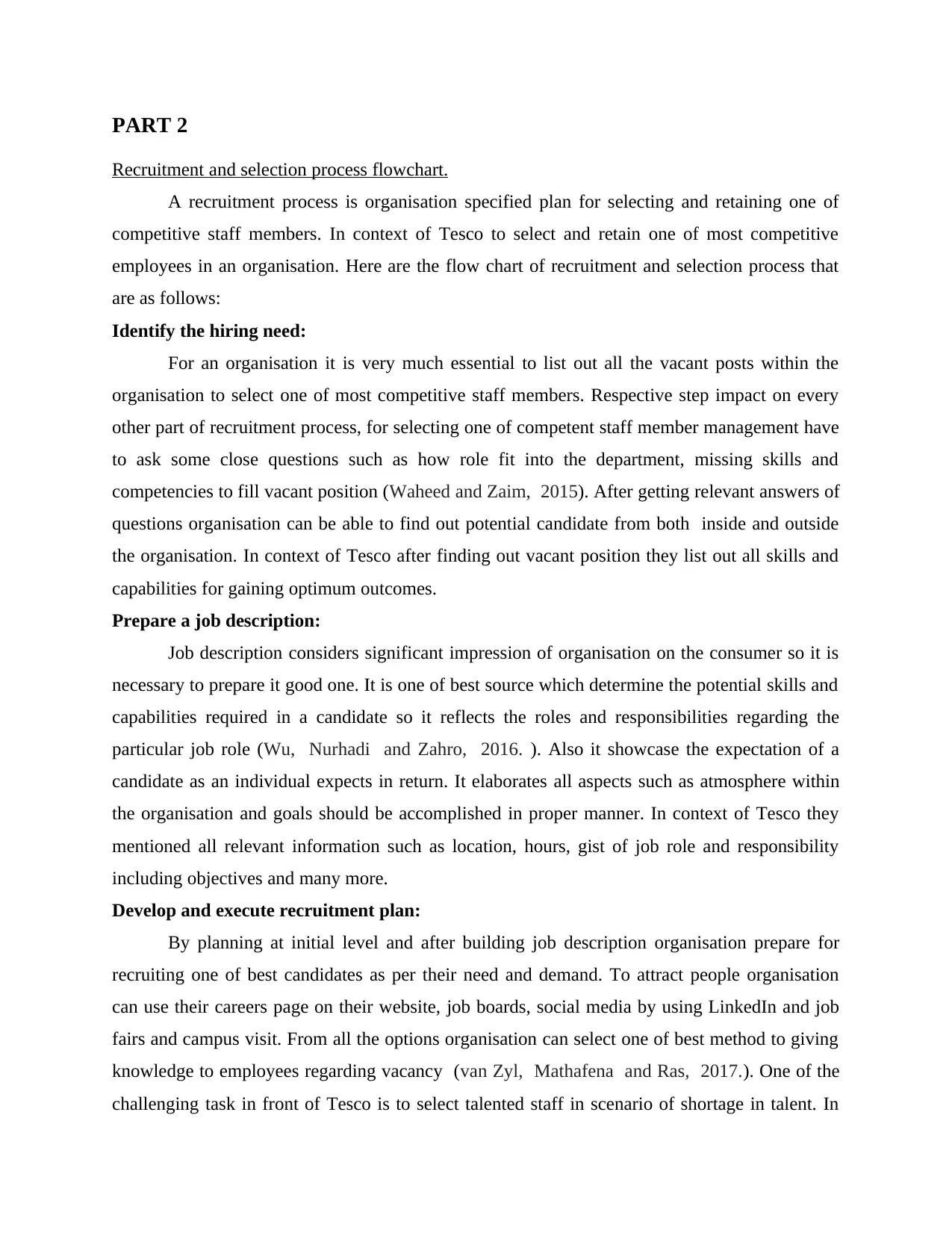
PART 2
Recruitment and selection process flowchart.
A recruitment process is organisation specified plan for selecting and retaining one of
competitive staff members. In context of Tesco to select and retain one of most competitive
employees in an organisation. Here are the flow chart of recruitment and selection process that
are as follows:
Identify the hiring need:
For an organisation it is very much essential to list out all the vacant posts within the
organisation to select one of most competitive staff members. Respective step impact on every
other part of recruitment process, for selecting one of competent staff member management have
to ask some close questions such as how role fit into the department, missing skills and
competencies to fill vacant position (Waheed and Zaim, 2015). After getting relevant answers of
questions organisation can be able to find out potential candidate from both inside and outside
the organisation. In context of Tesco after finding out vacant position they list out all skills and
capabilities for gaining optimum outcomes.
Prepare a job description:
Job description considers significant impression of organisation on the consumer so it is
necessary to prepare it good one. It is one of best source which determine the potential skills and
capabilities required in a candidate so it reflects the roles and responsibilities regarding the
particular job role (Wu, Nurhadi and Zahro, 2016. ). Also it showcase the expectation of a
candidate as an individual expects in return. It elaborates all aspects such as atmosphere within
the organisation and goals should be accomplished in proper manner. In context of Tesco they
mentioned all relevant information such as location, hours, gist of job role and responsibility
including objectives and many more.
Develop and execute recruitment plan:
By planning at initial level and after building job description organisation prepare for
recruiting one of best candidates as per their need and demand. To attract people organisation
can use their careers page on their website, job boards, social media by using LinkedIn and job
fairs and campus visit. From all the options organisation can select one of best method to giving
knowledge to employees regarding vacancy (van Zyl, Mathafena and Ras, 2017.). One of the
challenging task in front of Tesco is to select talented staff in scenario of shortage in talent. In
Recruitment and selection process flowchart.
A recruitment process is organisation specified plan for selecting and retaining one of
competitive staff members. In context of Tesco to select and retain one of most competitive
employees in an organisation. Here are the flow chart of recruitment and selection process that
are as follows:
Identify the hiring need:
For an organisation it is very much essential to list out all the vacant posts within the
organisation to select one of most competitive staff members. Respective step impact on every
other part of recruitment process, for selecting one of competent staff member management have
to ask some close questions such as how role fit into the department, missing skills and
competencies to fill vacant position (Waheed and Zaim, 2015). After getting relevant answers of
questions organisation can be able to find out potential candidate from both inside and outside
the organisation. In context of Tesco after finding out vacant position they list out all skills and
capabilities for gaining optimum outcomes.
Prepare a job description:
Job description considers significant impression of organisation on the consumer so it is
necessary to prepare it good one. It is one of best source which determine the potential skills and
capabilities required in a candidate so it reflects the roles and responsibilities regarding the
particular job role (Wu, Nurhadi and Zahro, 2016. ). Also it showcase the expectation of a
candidate as an individual expects in return. It elaborates all aspects such as atmosphere within
the organisation and goals should be accomplished in proper manner. In context of Tesco they
mentioned all relevant information such as location, hours, gist of job role and responsibility
including objectives and many more.
Develop and execute recruitment plan:
By planning at initial level and after building job description organisation prepare for
recruiting one of best candidates as per their need and demand. To attract people organisation
can use their careers page on their website, job boards, social media by using LinkedIn and job
fairs and campus visit. From all the options organisation can select one of best method to giving
knowledge to employees regarding vacancy (van Zyl, Mathafena and Ras, 2017.). One of the
challenging task in front of Tesco is to select talented staff in scenario of shortage in talent. In
Paraphrase This Document
Need a fresh take? Get an instant paraphrase of this document with our AI Paraphraser
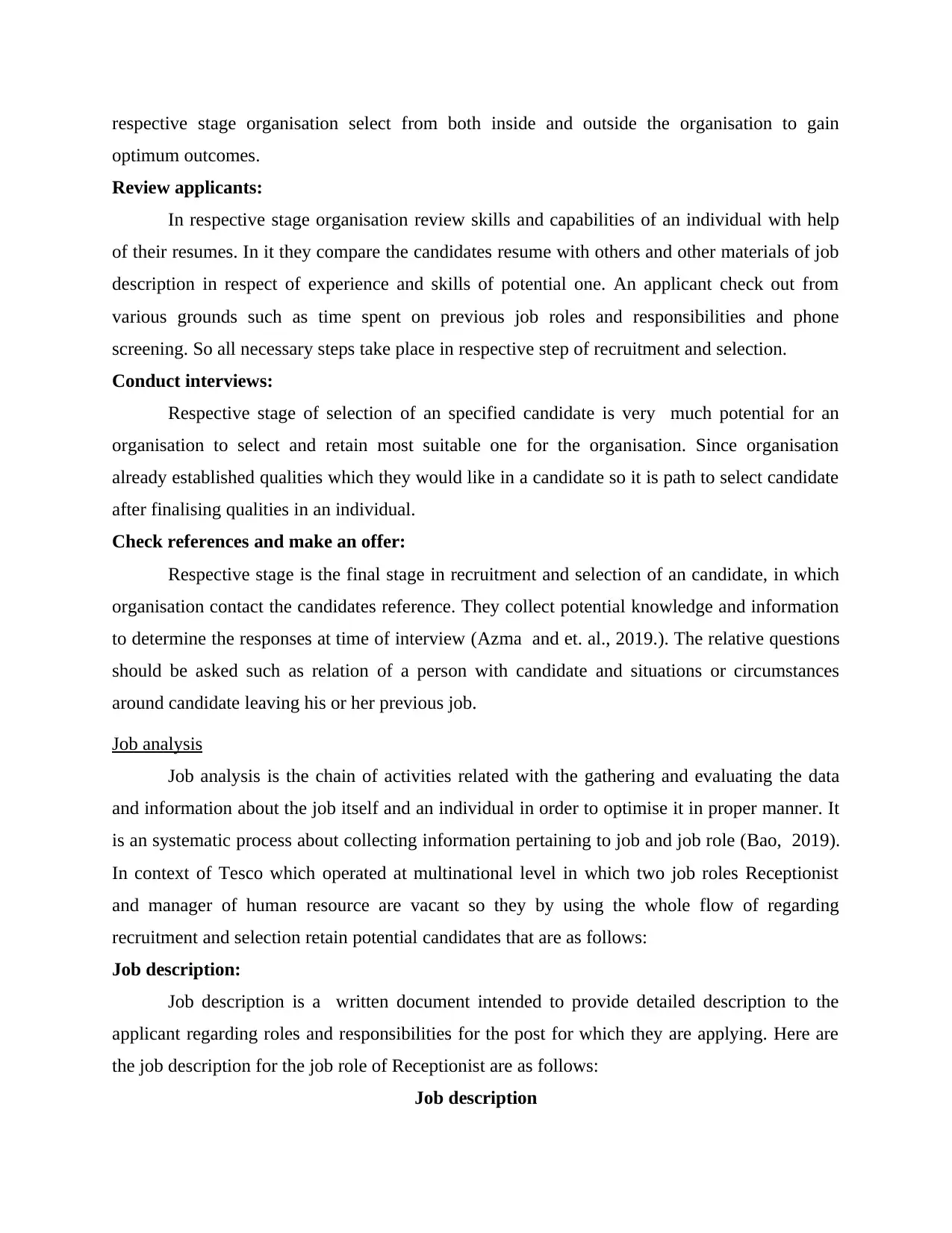
respective stage organisation select from both inside and outside the organisation to gain
optimum outcomes.
Review applicants:
In respective stage organisation review skills and capabilities of an individual with help
of their resumes. In it they compare the candidates resume with others and other materials of job
description in respect of experience and skills of potential one. An applicant check out from
various grounds such as time spent on previous job roles and responsibilities and phone
screening. So all necessary steps take place in respective step of recruitment and selection.
Conduct interviews:
Respective stage of selection of an specified candidate is very much potential for an
organisation to select and retain most suitable one for the organisation. Since organisation
already established qualities which they would like in a candidate so it is path to select candidate
after finalising qualities in an individual.
Check references and make an offer:
Respective stage is the final stage in recruitment and selection of an candidate, in which
organisation contact the candidates reference. They collect potential knowledge and information
to determine the responses at time of interview (Azma and et. al., 2019.). The relative questions
should be asked such as relation of a person with candidate and situations or circumstances
around candidate leaving his or her previous job.
Job analysis
Job analysis is the chain of activities related with the gathering and evaluating the data
and information about the job itself and an individual in order to optimise it in proper manner. It
is an systematic process about collecting information pertaining to job and job role (Bao, 2019).
In context of Tesco which operated at multinational level in which two job roles Receptionist
and manager of human resource are vacant so they by using the whole flow of regarding
recruitment and selection retain potential candidates that are as follows:
Job description:
Job description is a written document intended to provide detailed description to the
applicant regarding roles and responsibilities for the post for which they are applying. Here are
the job description for the job role of Receptionist are as follows:
Job description
optimum outcomes.
Review applicants:
In respective stage organisation review skills and capabilities of an individual with help
of their resumes. In it they compare the candidates resume with others and other materials of job
description in respect of experience and skills of potential one. An applicant check out from
various grounds such as time spent on previous job roles and responsibilities and phone
screening. So all necessary steps take place in respective step of recruitment and selection.
Conduct interviews:
Respective stage of selection of an specified candidate is very much potential for an
organisation to select and retain most suitable one for the organisation. Since organisation
already established qualities which they would like in a candidate so it is path to select candidate
after finalising qualities in an individual.
Check references and make an offer:
Respective stage is the final stage in recruitment and selection of an candidate, in which
organisation contact the candidates reference. They collect potential knowledge and information
to determine the responses at time of interview (Azma and et. al., 2019.). The relative questions
should be asked such as relation of a person with candidate and situations or circumstances
around candidate leaving his or her previous job.
Job analysis
Job analysis is the chain of activities related with the gathering and evaluating the data
and information about the job itself and an individual in order to optimise it in proper manner. It
is an systematic process about collecting information pertaining to job and job role (Bao, 2019).
In context of Tesco which operated at multinational level in which two job roles Receptionist
and manager of human resource are vacant so they by using the whole flow of regarding
recruitment and selection retain potential candidates that are as follows:
Job description:
Job description is a written document intended to provide detailed description to the
applicant regarding roles and responsibilities for the post for which they are applying. Here are
the job description for the job role of Receptionist are as follows:
Job description
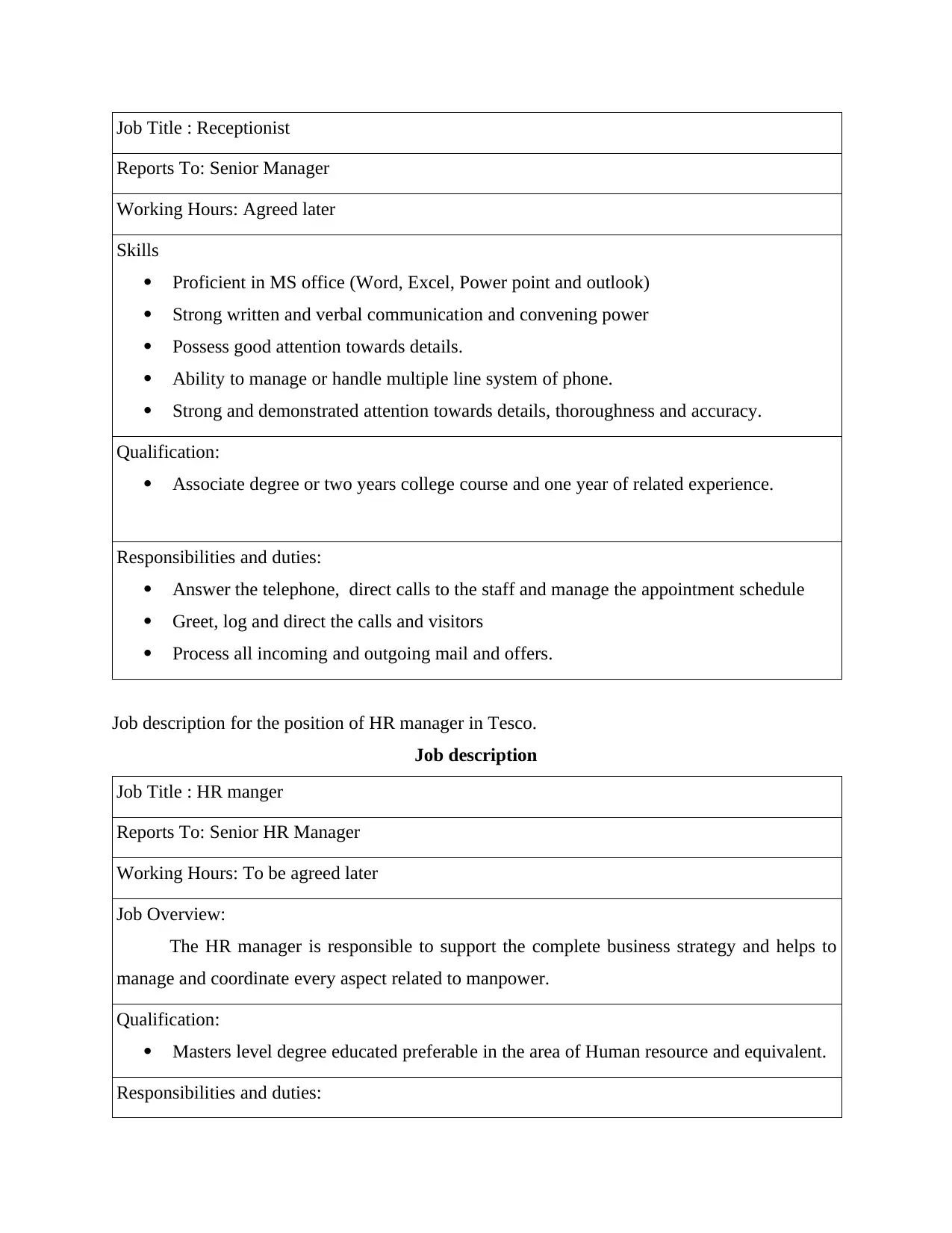
Job Title : Receptionist
Reports To: Senior Manager
Working Hours: Agreed later
Skills
Proficient in MS office (Word, Excel, Power point and outlook)
Strong written and verbal communication and convening power
Possess good attention towards details.
Ability to manage or handle multiple line system of phone.
Strong and demonstrated attention towards details, thoroughness and accuracy.
Qualification:
Associate degree or two years college course and one year of related experience.
Responsibilities and duties:
Answer the telephone, direct calls to the staff and manage the appointment schedule
Greet, log and direct the calls and visitors
Process all incoming and outgoing mail and offers.
Job description for the position of HR manager in Tesco.
Job description
Job Title : HR manger
Reports To: Senior HR Manager
Working Hours: To be agreed later
Job Overview:
The HR manager is responsible to support the complete business strategy and helps to
manage and coordinate every aspect related to manpower.
Qualification:
Masters level degree educated preferable in the area of Human resource and equivalent.
Responsibilities and duties:
Reports To: Senior Manager
Working Hours: Agreed later
Skills
Proficient in MS office (Word, Excel, Power point and outlook)
Strong written and verbal communication and convening power
Possess good attention towards details.
Ability to manage or handle multiple line system of phone.
Strong and demonstrated attention towards details, thoroughness and accuracy.
Qualification:
Associate degree or two years college course and one year of related experience.
Responsibilities and duties:
Answer the telephone, direct calls to the staff and manage the appointment schedule
Greet, log and direct the calls and visitors
Process all incoming and outgoing mail and offers.
Job description for the position of HR manager in Tesco.
Job description
Job Title : HR manger
Reports To: Senior HR Manager
Working Hours: To be agreed later
Job Overview:
The HR manager is responsible to support the complete business strategy and helps to
manage and coordinate every aspect related to manpower.
Qualification:
Masters level degree educated preferable in the area of Human resource and equivalent.
Responsibilities and duties:
⊘ This is a preview!⊘
Do you want full access?
Subscribe today to unlock all pages.

Trusted by 1+ million students worldwide
1 out of 22
Related Documents
Your All-in-One AI-Powered Toolkit for Academic Success.
+13062052269
info@desklib.com
Available 24*7 on WhatsApp / Email
![[object Object]](/_next/static/media/star-bottom.7253800d.svg)
Unlock your academic potential
Copyright © 2020–2025 A2Z Services. All Rights Reserved. Developed and managed by ZUCOL.




